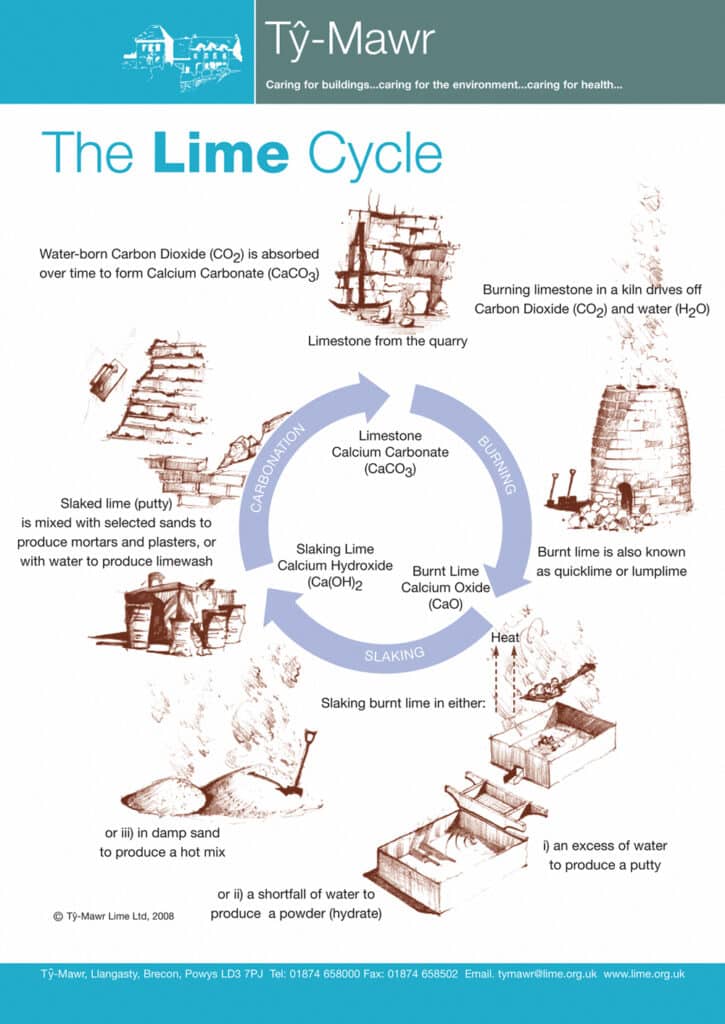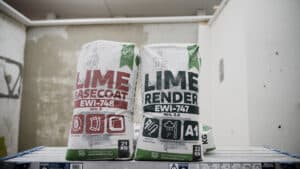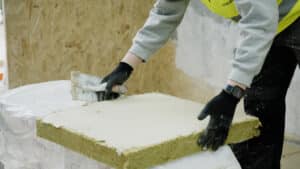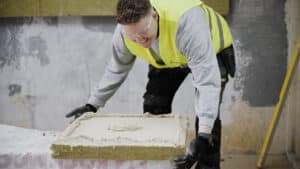4.8 out of 5 Stars on TrustPilot
Lime Render vs Cement Render
When rendering a property’s exterior, the choice of material is crucial for both aesthetic appeal and the longevity of the wall finish. Lime render and cement render are two of the most common types of materials used in the UK, each with its benefits and drawbacks. This blog explores the differences between lime and cement render, helping you decide the best option for your property.
Lime render
Lime render stands out for its unique properties that cater to the well-being of a building’s structure, especially in older or historic properties. Originating from a blend of lime, water, and aggregates like sand, this traditional material has graced the exteriors of buildings for centuries, offering a breathable coat that significantly aids in moisture management within walls.
Breathability
One of the paramount benefits of lime render is its ability to allow moisture to permeate and evaporate away. This breathability is crucial for maintaining healthy walls, especially in older buildings constructed without modern damp-proofing techniques. By allowing moisture to escape, lime render prevents the accumulation of dampness within walls, safeguarding against the structural issues and mould growth that moisture can cause. This characteristic is particularly vital in the UK, where damp climates consistently challenge building maintenance.
Aesthetics
Beyond its practical benefits, lime render also brings aesthetic versatility. It can be applied in various textures and finishes, from smooth to coarse, catering to various architectural styles and preferences. Moreover, when lime renders age, it gracefully develops a patina that adds character and depth to a building’s appearance. This natural ageing process can enhance the visual appeal of heritage properties, blending seamlessly with their historical context.
Sustainability
However, the advantages of lime render extend beyond the physical to the environmental. Lime is a more sustainable material than its contemporary counterparts, such as cement. During the curing process, lime render absorbs carbon dioxide from the atmosphere, undergoing a carbonation process. This not only contributes to the strength and durability of the render but also reduces the carbon footprint. The production of lime is less energy-intensive compared to cement, further enhancing its eco-friendly credentials.
Yet, the adoption of lime render comes with considerations of cost and skill. The material itself, alongside the expertise required for its application, can be more costly than other rendering options. Its application is an art requiring skilled tradespeople familiar with traditional building techniques. Additionally, lime render takes longer to cure than cement-based products, necessitating patience and careful planning to ensure longevity and effectiveness.
Lime Basecoat and Lime Render in action in the EWI Pro Training Centre
Cement render
Cement render has become a staple in modern construction, valued for its robustness and versatility across various building types. This popular rendering option is composed of a mixture of cement, sand, and, in some mixes, a small proportion of lime to enhance workability and reduce the likelihood of cracking. Its appeal lies in its physical strength and durability, as well as its cost-effectiveness and adaptability to various architectural aesthetics.
Durability
The primary advantage of cement render is its exceptional durability. Once applied, it forms a hard, resistant surface that stands up well against environmental elements, from harsh weather conditions to everyday wear and tear. This resilience makes cement an ideal choice for buildings in areas exposed to severe weather. The solidity of cement render also enhances the structural integrity of buildings, providing an additional layer of protection against physical impacts.
Cost
Cost efficiency is another significant benefit of choosing cement render. Compared to other rendering materials like lime, cement render is generally more affordable regarding the raw materials and the labour costs associated with its application. This makes it popular for larger projects or property owners working within tight budget constraints. The straightforward mixing and application process makes it cost-effective, allowing for a quicker project turnaround without compromising quality.
Aesthetics
Cement render also boasts considerable versatility in terms of aesthetics. It can be finished in various textures, from smooth to patterned, and painted in any colour, offering endless possibilities for customisation. This adaptability enables property owners to achieve a wide range of looks. This ranges from contemporary sharpness to a more traditional or rustic appearance. Furthermore, innovations in cement render compositions have led to the development of coloured and textured renders, reducing the need for subsequent painting and offering even more options for personalisation.
However, the choice of cement render comes with consideration. Its lower breathability than lime render can pose challenges in older buildings, where trapped moisture may lead to damp issues. Moreover, cement render is less prone to cracking than pure cement due to the addition of lime or plasticisers; it can still crack if the building settles or is subject to thermal expansion. This necessitates careful application and, in some cases, ongoing maintenance to ensure the render remains in optimal condition.
Lime render vs Cement render – which one is better for your project?
Compatibility with older buildings
Lime render’s compatibility with older buildings starkly contrasts with cement render’s limitations in such environments. The breathability of lime render allows moisture to move freely through the wall, preventing the build-up of dampness and related structural damage. Cement render, on the other hand, can trap moisture within walls due to its lower permeability. This can lead to damp problems and deteriorate the condition of historic masonry, making cement a less suitable option for heritage buildings or those constructed with traditional materials.
Environmental impact
The environmental implications of choosing between lime and cement render are significant. Lime render’s production process is inherently more eco-friendly, emitting less carbon dioxide than cement’s energy-intensive manufacturing. Additionally, lime’s ability to reabsorb CO2 during the carbonation process renders it carbon neutral over its lifecycle. Cement render, by contrast, contributes significantly to CO2 emissions without the capacity to offset this impact. Consequently, it is a less sustainable choice for environmentally conscious projects.

Flexibility and aesthetic qualities
The natural flexibility of lime render dramatically reduces the risk of cracking that is prevalent with cement render. Cement render’s rigidity, while providing strength, does not well accommodate building movement or thermal shifts. Ultimately, this leads to cracks that require repair to maintain structural integrity and aesthetic appearance. Lime render, adaptable to the subtle shifts in building structure, maintains its integrity over time, preserving the building’s aesthetic without the frequent maintenance cement render might necesitate.
Healthier living environments
Lime render contributes to healthier indoor environments by regulating humidity levels, and reducing mould and mildew growth potential. This is a stark difference from cement render, which, due to its lower breathability, can create conditions that foster mould growth by trapping moisture. The ability of lime render to allow walls to breathe protects the building’s structural health and promotes better indoor air quality, making it a preferable choice for living spaces.
Facebook
Twitter
LinkedIn
Your cart
Trade Account Login

We use cookies on our website to give you the most relevant experience by remembering your preferences and repeat visits. By clicking “Accept All”, you consent to the use of ALL the cookies. However, you may visit "Cookie Settings" to provide personalised consent.
Manage consent
Privacy Overview
This website uses cookies to improve your experience while you navigate through the website. Out of these, the cookies that are categorized as necessary are stored on your browser as they are essential for the working of basic functionalities of the website. We also use third-party cookies that help us analyze and understand how you use this website. These cookies will be stored in your browser only with your consent. You also have the option to opt-out of these cookies. But opting out of some of these cookies may affect your browsing experience.
Necessary cookies are absolutely essential for the website to function properly. These cookies ensure basic functionalities and security features of the website, anonymously.
| Cookie | Duration | Description |
|---|---|---|
| __stripe_mid | 1 year | This cookie is set by Stripe payment gateway. This cookie is used to enable payment on the website without storing any patment information on a server. |
| __stripe_sid | 30 minutes | This cookie is set by Stripe payment gateway. This cookie is used to enable payment on the website without storing any patment information on a server. |
| _GRECAPTCHA | 5 months 27 days | This cookie is set by the Google recaptcha service to identify bots to protect the website against malicious spam attacks. |
| apbct_cookies_test | session | CleanTalk sets this cookie to prevent spam on comments and forms and act as a complete anti-spam solution and firewall for the site. |
| apbct_page_hits | session | CleanTalk sets this cookie to prevent spam on comments and forms and act as a complete anti-spam solution and firewall for the site. |
| apbct_prev_referer | session | Functional cookie placed by CleanTalk Spam Protect to store referring IDs and prevent unauthorized spam from being sent from the website. |
| apbct_site_landing_ts | session | CleanTalk sets this cookie to prevent spam on comments and forms and act as a complete anti-spam solution and firewall for the site. |
| apbct_site_referer | 3 days | This cookie is placed by CleanTalk Spam Protect to prevent spam and to store the referrer page address which led the user to the website. |
| apbct_timestamp | session | CleanTalk sets this cookie to prevent spam on comments and forms and act as a complete anti-spam solution and firewall for the site. |
| apbct_urls | 3 days | This cookie is placed by CleanTalk Spam Protect to prevent spam and to store the addresses (urls) visited on the website. |
| AWSALBCORS | 7 days | This cookie is managed by Amazon Web Services and is used for load balancing. |
| cookielawinfo-checkbox-advertisement | 1 year | Set by the GDPR Cookie Consent plugin, this cookie is used to record the user consent for the cookies in the "Advertisement" category . |
| cookielawinfo-checkbox-analytics | 11 months | This cookie is set by GDPR Cookie Consent plugin. The cookie is used to store the user consent for the cookies in the category "Analytics". |
| cookielawinfo-checkbox-functional | 11 months | The cookie is set by GDPR cookie consent to record the user consent for the cookies in the category "Functional". |
| cookielawinfo-checkbox-necessary | 11 months | This cookie is set by GDPR Cookie Consent plugin. The cookies is used to store the user consent for the cookies in the category "Necessary". |
| cookielawinfo-checkbox-others | 11 months | This cookie is set by GDPR Cookie Consent plugin. The cookie is used to store the user consent for the cookies in the category "Other. |
| cookielawinfo-checkbox-performance | 11 months | This cookie is set by GDPR Cookie Consent plugin. The cookie is used to store the user consent for the cookies in the category "Performance". |
| ct_checkjs | session | CleanTalk–Used to prevent spam on our comments and forms and acts as a complete anti-spam solution and firewall for this site. |
| ct_fkp_timestamp | session | CleanTalk sets this cookie to prevent spam on the site's comments/forms, and to act as a complete anti-spam solution and firewall for the site. |
| ct_pointer_data | session | CleanTalk sets this cookie to prevent spam on the site's comments/forms, and to act as a complete anti-spam solution and firewall for the site. |
| ct_ps_timestamp | session | CleanTalk sets this cookie to prevent spam on the site's comments/forms, and to act as a complete anti-spam solution and firewall for the site. |
| ct_sfw_pass_key | 1 month | CleanTalk sets this cookie to prevent spam on comments and forms and act as a complete anti-spam solution and firewall for the site. |
| ct_timezone | session | CleanTalk–Used to prevent spam on our comments and forms and acts as a complete anti-spam solution and firewall for this site. |
| elementor | never | This cookie is used by the website's WordPress theme. It allows the website owner to implement or change the website's content in real-time. |
| viewed_cookie_policy | 11 months | The cookie is set by the GDPR Cookie Consent plugin and is used to store whether or not user has consented to the use of cookies. It does not store any personal data. |
Functional cookies help to perform certain functionalities like sharing the content of the website on social media platforms, collect feedbacks, and other third-party features.
| Cookie | Duration | Description |
|---|---|---|
| __zlcmid | 1 year | This cookie is used by Zendesk live chat and is used to store the live chat ID. |
| bcookie | 2 years | LinkedIn sets this cookie from LinkedIn share buttons and ad tags to recognize browser ID. |
| bscookie | 2 years | LinkedIn sets this cookie to store performed actions on the website. |
| lang | session | LinkedIn sets this cookie to remember a user's language setting. |
| lidc | 1 day | LinkedIn sets the lidc cookie to facilitate data center selection. |
| UserMatchHistory | 1 month | LinkedIn sets this cookie for LinkedIn Ads ID syncing. |
Performance cookies are used to understand and analyze the key performance indexes of the website which helps in delivering a better user experience for the visitors.
| Cookie | Duration | Description |
|---|---|---|
| __utma | 2 years | This cookie is set by Google Analytics and is used to distinguish users and sessions. The cookie is created when the JavaScript library executes and there are no existing __utma cookies. The cookie is updated every time data is sent to Google Analytics. |
| __utmb | 30 minutes | Google Analytics sets this cookie, to determine new sessions/visits. __utmb cookie is created when the JavaScript library executes and there are no existing __utma cookies. It is updated every time data is sent to Google Analytics. |
| __utmc | session | The cookie is set by Google Analytics and is deleted when the user closes the browser. It is used to enable interoperability with urchin.js, which is an older version of Google Analytics and is used in conjunction with the __utmb cookie to determine new sessions/visits. |
| __utmt | 10 minutes | Google Analytics sets this cookie to inhibit request rate. |
| __utmv | 2 years | The __utmv cookie is set on the user's device, to enable Google Analytics to classify the visitor. |
| __utmz | 6 months | Google Analytics sets this cookie to store the traffic source or campaign by which the visitor reached the site. |
| sib_cuid | 6 months | Purechat uses this cookie to send data to purechat.com, to connect visitors to the reservation team and track visitors to stay on portal. |
| SRM_B | 1 year 24 days | Used by Microsoft Advertising as a unique ID for visitors. |
Analytical cookies are used to understand how visitors interact with the website. These cookies help provide information on metrics the number of visitors, bounce rate, traffic source, etc.
| Cookie | Duration | Description |
|---|---|---|
| _ga | 2 years | The _ga cookie, installed by Google Analytics, calculates visitor, session and campaign data and also keeps track of site usage for the site's analytics report. The cookie stores information anonymously and assigns a randomly generated number to recognize unique visitors. |
| _gat_gtag_UA_61069204_2 | 1 minute | Set by Google to distinguish users. |
| _gat_UA-61069204-2 | 1 minute | A variation of the _gat cookie set by Google Analytics and Google Tag Manager to allow website owners to track visitor behaviour and measure site performance. The pattern element in the name contains the unique identity number of the account or website it relates to. |
| _gcl_au | 3 months | Provided by Google Tag Manager to experiment advertisement efficiency of websites using their services. |
| _gid | 1 day | Installed by Google Analytics, _gid cookie stores information on how visitors use a website, while also creating an analytics report of the website's performance. Some of the data that are collected include the number of visitors, their source, and the pages they visit anonymously. |
| _uetsid | 1 day | This cookies are used to collect analytical information about how visitors use the website. This information is used to compile report and improve site. |
| CONSENT | 2 years | YouTube sets this cookie via embedded youtube-videos and registers anonymous statistical data. |
Advertisement cookies are used to provide visitors with relevant ads and marketing campaigns. These cookies track visitors across websites and collect information to provide customized ads.
| Cookie | Duration | Description |
|---|---|---|
| _fbp | 3 months | This cookie is set by Facebook to display advertisements when either on Facebook or on a digital platform powered by Facebook advertising, after visiting the website. |
| ANONCHK | 10 minutes | The ANONCHK cookie, set by Bing, is used to store a user's session ID and also verify the clicks from ads on the Bing search engine. The cookie helps in reporting and personalization as well. |
| fr | 3 months | Facebook sets this cookie to show relevant advertisements to users by tracking user behaviour across the web, on sites that have Facebook pixel or Facebook social plugin. |
| MUID | 1 year 24 days | Bing sets this cookie to recognize unique web browsers visiting Microsoft sites. This cookie is used for advertising, site analytics, and other operations. |
| NID | 6 months | NID cookie, set by Google, is used for advertising purposes; to limit the number of times the user sees an ad, to mute unwanted ads, and to measure the effectiveness of ads. |
| test_cookie | 15 minutes | The test_cookie is set by doubleclick.net and is used to determine if the user's browser supports cookies. |
| uuid | 6 months | MediaMath sets this cookie to avoid the same ads from being shown repeatedly and for relevant advertising. |
| VISITOR_INFO1_LIVE | 5 months 27 days | A cookie set by YouTube to measure bandwidth that determines whether the user gets the new or old player interface. |
| YSC | session | YSC cookie is set by Youtube and is used to track the views of embedded videos on Youtube pages. |
| yt-remote-connected-devices | never | YouTube sets this cookie to store the video preferences of the user using embedded YouTube video. |
| yt-remote-device-id | never | YouTube sets this cookie to store the video preferences of the user using embedded YouTube video. |
| yt.innertube::nextId | never | This cookie, set by YouTube, registers a unique ID to store data on what videos from YouTube the user has seen. |
| yt.innertube::requests | never | This cookie, set by YouTube, registers a unique ID to store data on what videos from YouTube the user has seen. |
Other uncategorized cookies are those that are being analyzed and have not been classified into a category as yet.
| Cookie | Duration | Description |
|---|---|---|
| _clck | 1 year | No description |
| _clsk | 1 day | No description |
| _uetvid | 1 year 24 days | No description available. |
| AnalyticsSyncHistory | 1 month | No description |
| apbct_pixel_url | session | No description |
| apbct_visible_fields_0 | session | No description |
| apbct_visible_fields_1 | session | No description |
| apbct_visible_fields_10 | session | No description |
| apbct_visible_fields_2 | session | No description |
| apbct_visible_fields_3 | session | No description |
| apbct_visible_fields_4 | session | No description |
| apbct_visible_fields_5 | session | No description |
| apbct_visible_fields_6 | session | No description |
| apbct_visible_fields_7 | session | No description |
| apbct_visible_fields_8 | session | No description |
| apbct_visible_fields_9 | session | No description |
| ct_checked_emails | session | No description |
| ct_has_scrolled | session | No description |
| ct_mouse_moved | session | No description |
| ct_screen_info | session | No description |
| ictf_master | never | No description available. |
| li_gc | 2 years | No description |
| m | 2 years | No description available. |
| SM | session | No description available. |
| testinfinitycookie | session | No description |
| woocommerce_show_tax | 7 days | No description available. |
| wp_woocommerce_session_c5ac76b408021294cb56bcc27eddf8a1 | 2 days | No description |







